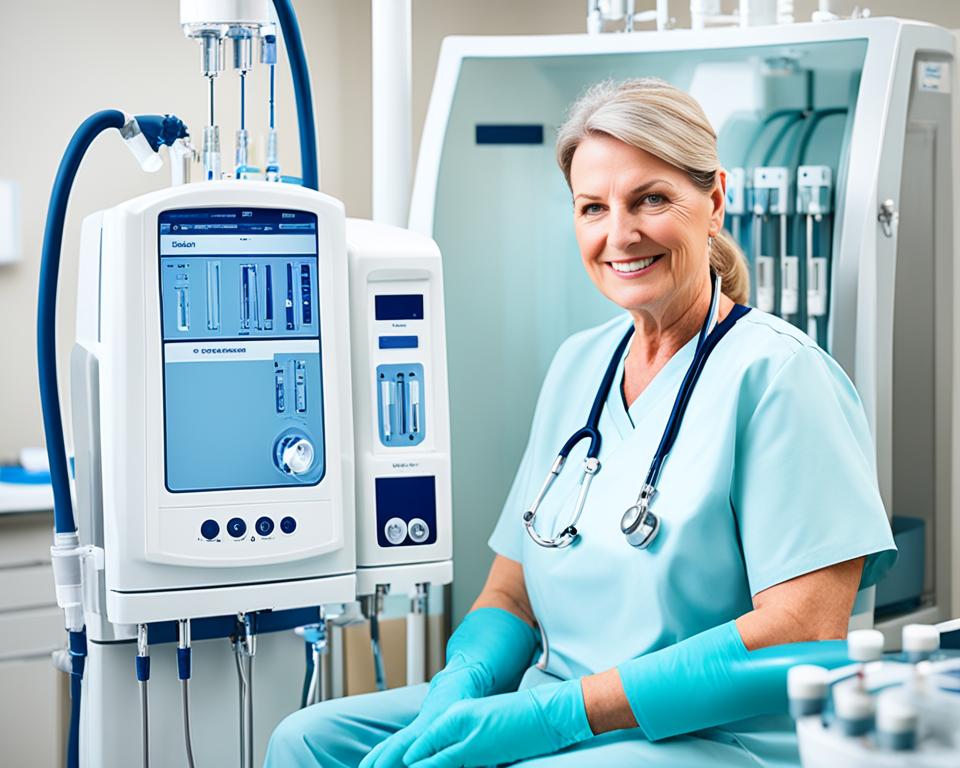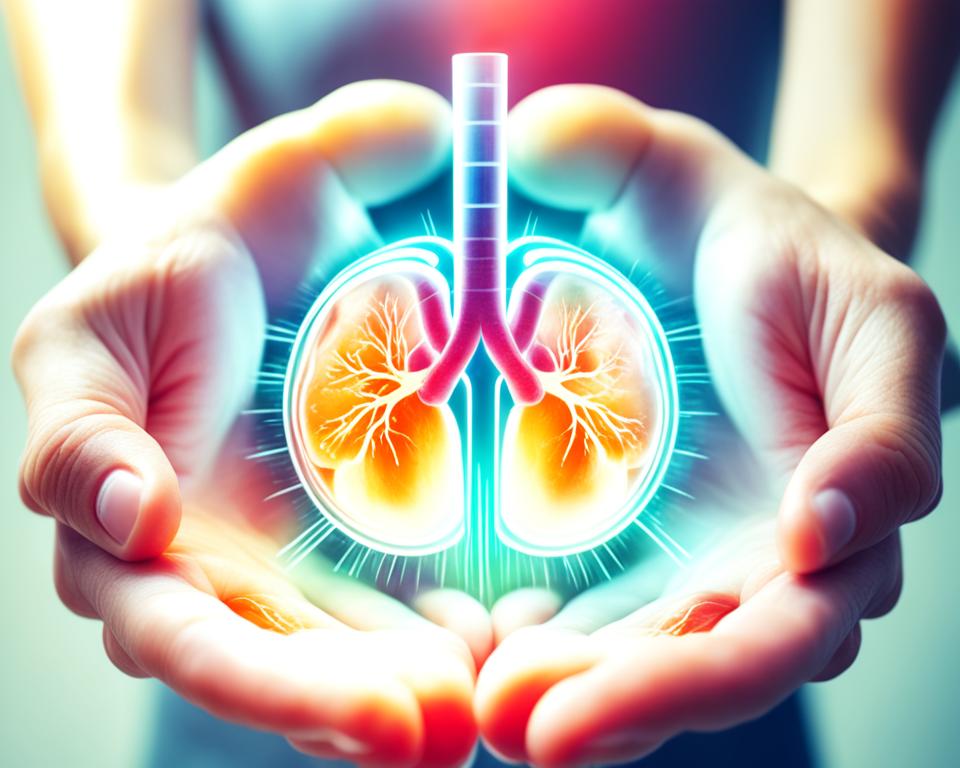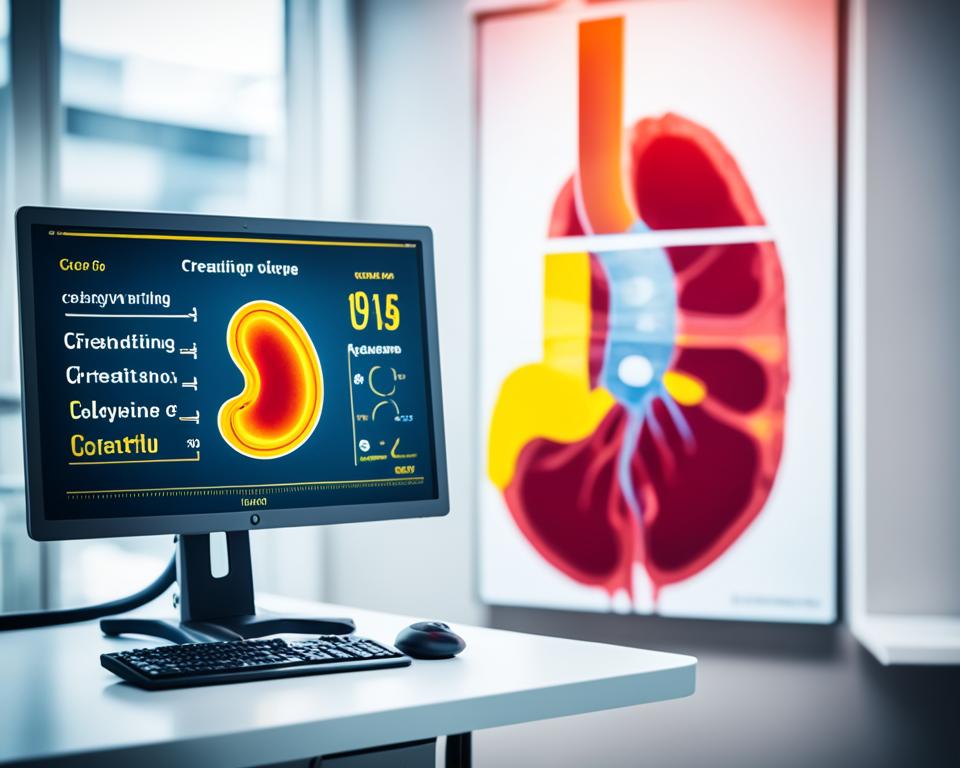Creatinine is a key clue about the health of our kidneys. It’s made when our muscles work normally and acts as a waste. If your kidneys aren’t working right, creatinine builds up in the blood. This can show if you need dialysis. We’ll explain what creatinine levels mean for your kidney health and when dialysis might be necessary.
Read interesting things at : kamilyle
Key Takeaways
- Creatinine comes from our muscles and is usually filtered out by the kidneys.
- High creatinine levels can mean you have a kidney problem and might need dialysis.
- What’s normal for creatinine depends on your age, sex, and how much muscle you have. But, it’s usually between 0.6 and 1.2 mg/dL.
- Doctors often suggest dialysis if your creatinine level goes above 5 mg/dL. This could mean your kidneys are in bad shape.
- Keeping an eye on your creatinine levels and treating kidney diseases early can sometimes prevent the need for dialysis.
Understanding Creatinine and Its Role in Kidney Health
Creatinine gives us key knowledge about our kidneys. It comes from breaking down muscle waste and is cleared by the kidneys. Monitoring creatinine shows how well our kidneys filter our blood.
What is Creatinine?
It’s a natural byproduct of muscle action. The body gets rid of it through urine. High levels can mean our kidneys aren’t working right.
How Creatinine Levels Indicate Kidney Function
Healthy kidneys remove creatinine well. But if they’re damaged, creatinine builds up. This tells us about the kidneys’ health.
High creatinine is linked with chronic kidney disease. Checking creatinine helps track and treat kidney problems.
“Creatinine levels are a key indicator of kidney function, providing valuable insights into the overall health of this vital organ.”
Knowing about creatinine helps catch kidney issues early. Doctors use this knowledge to keep our kidneys working well.
Causes of Elevated Creatinine Levels
The kidneys filter creatinine out of our blood. If they don’t work well, creatinine levels in our blood go up. This hints at possible kidney issues. Chronic kidney disease and acute kidney injury are two key causes.
Chronic Kidney Disease
Chronic kidney disease is a lasting issue, slowly weakening the kidneys. The kidneys start to fail in their duty to clear away body waste. This leads to higher creatinine levels in the blood. It’s often because of diseases like diabetes or high blood pressure, which hurt the kidneys.
Acute Kidney Injury
Acute kidney injury is a fast loss of kidney function. It quickly raises creatinine in the blood. Things like not drinking enough, infections, some drugs, or a blockage can cause it. But, it’s generally fixable with quick medical help.
Spotting and treating chronic kidney disease and acute kidney injury early is crucial. This cuts the chances of more kidney harm and complications. Checking creatinine levels often and tackling the main issues keeps kidneys as healthy as possible.
Normal Creatinine Levels and Ranges
Creatinine is a waste product the kidneys take out of the blood. It’s key to know what normal creatinine levels are. This helps catch kidney problems early. Normal levels change with age, sex, and body size.
For adults, the normal creatinine range is 0.6 to 1.2 mg/dL for women and 0.9 to 1.3 mg/dL for men. These numbers can slightly vary for each person.
- Men usually have higher creatinine levels than women because they have more muscle.
- As we get older, creatinine levels can go up naturally.
- Those who are bigger or have more muscle might also have higher normal levels.
But, just one high creatinine level doesn’t always mean there’s a problem. Fluctuations happen for many reasons. These include not drinking enough, certain drugs, or changes in kidney health. Doctors watch creatinine levels over time to spot issues early.
“Keeping creatinine levels in check shows our kidneys are healthy. Getting regular check-ups helps find issues before they get serious.”
Knowing about creatinine levels and what affects them can help everyone work with their doctors. This ensures our kidneys are looked after and any problems are caught early.
https://www.youtube.com/watch?v=71ns37P1KIg
When Dialysis Is Needed Creatinine Levels
Creatinine levels are key in deciding when someone needs dialysis for chronic kidney disease (CKD). As kidneys get more damaged, they can’t filter creatinine well. This raises the creatinine levels in the blood.
Stages of Chronic Kidney Disease
Chronic kidney disease has five stages, decided by the estimated glomerular filtration rate (eGFR). This rate shows how much blood the kidneys filter each minute. As CKD advances, creatinine levels get higher, signaling that dialysis might be needed soon.
- Stage 1 (eGFR ≥ 90 mL/min/1.73m²): Mild kidney damage, with normal or slightly elevated creatinine levels.
- Stage 2 (eGFR 60-89 mL/min/1.73m²): Mild to moderate kidney damage, with slightly elevated creatinine levels.
- Stage 3 (eGFR 30-59 mL/min/1.73m²): Moderate to severe kidney damage, creatinine mostly between 1.5 to 3 mg/dL.
- Stage 4 (eGFR 15-29 mL/min/1.73m²): Severe kidney damage, often with creatinine over 3 mg/dL.
- Stage 5 (eGFR
End-Stage Renal Disease (ESRD)
At end-stage renal disease (ESRD), the kidneys are very damaged and usually can’t work well. Here, creatinine levels are usually over 5 mg/dL, and dialysis becomes necessary. Dialysis helps decrease creatinine and other waste, and it keeps fluids and electrolytes in balance.
By watching creatinine levels and CKD’s progress, doctors know when to start dialysis. This ensures patients get care in time, helping their health and well-being.
Diagnosing Kidney Dysfunction: Tests and Procedures
Maintaining kidney health is super important. Your kidneys are key for cleaning waste from your body. If they start to work less, you need tests to find out why.
These tests tell your doctor how well your kidneys clean your blood. A common one is the glomerular filtration rate (GFR) test.
Glomerular Filtration Rate (GFR) Test
The GFR test checks how well your kidneys work. It looks at the blood to see how fast your kidneys can take out waste. This test is very good for finding kidney problems and seeing how bad they are.
To do a GFR test, your blood will be checked. They look for creatinine, a waste that healthy kidneys usually take out. The level of creatinine helps doctors find your GFR.
For most people, a healthy GFR is 90 to 120. Below 60 might mean your kidneys are struggling. If your GFR is low, you might need more tests to see what’s wrong.
Knowing about the GFR test and getting regular kidney checkups is smart. It helps you catch and treat kidney problems early. This can help keep you healthy and feel better.
Types of Dialysis Treatments
When the kidneys can’t work as they should, dialysis steps in to help. It does what the kidneys should, cleaning the blood and getting rid of extra fluid. There are two key kinds of dialysis: hemodialysis and peritoneal dialysis. They each have their own benefits for the patient.
Hemodialysis
Hemodialysis is more common. It filters a patient’s blood with a machine to cleanse it of harmful stuff and too much fluid. In this process, the blood is pulled out of the body by a tube, cleansed in a filter, and then put back in. Usually, a patient will have this done three times a week, each session lasting about 3 to 4 hours.
Hemodialysis is good at removing waste and fluid fast. Doctors can watch the patient closely during the treatment. But, the downside is patients must travel to a center or hospital for these sessions. It can throw off their daily life.
Peritoneal Dialysis
Peritoneal dialysis uses the lining of the patient’s belly as a filter. A special liquid is put into the belly to soak up waste and extra fluid. Then, this liquid is taken out. This happens a few times a day.
This way, patients can do peritoneal dialysis at home. It offers more freedom and is usually easier on the body for some people. Yet, doing it right to avoid infections needs careful work and a clean area.
Deciding between hemodialysis and peritoneal dialysis is careful work. It should be decided with the healthcare team, thinking about the patient’s health, way of life, and what they prefer.

Managing Kidney Disease and Creatinine Levels
For those with kidney disease, keeping creatinine levels in check is key. This helps slow down the disease and boosts overall health. Creatinine is a byproduct of muscle work and shows how well your kidneys are working. With the right diet tweaks and lifestyle changes, you can help take control of your kidney health.
Lifestyle Changes and Dietary Modifications
Changing what you eat and how you live can be a big help for your kidneys. It lowers their workload and keeps them functioning well.
- Maintain a Healthy Body Weight: A balanced diet and exercise can ease the strain on your kidneys and keep creatinine levels in check.
- Limit Protein Intake: Eating less protein, especially from animals, can cut down on how much creatinine your body makes.
- Increase Fluid Intake: Drinking lots of water helps thin out your blood’s waste, which makes it simpler for your kidneys to remove these waste products.
- Reduce Sodium Intake: Cutting back on salty foods and using less salt can lower your blood pressure. This makes life easier for your kidneys.
- Engage in Regular Physical Activity: Light to moderate exercise isn’t just good for your heart; it also helps your kidneys.
By making these changes in your life, you can better manage your creatinine levels. This might also help your kidney disease from getting worse.
| Lifestyle Change | Potential Benefits |
|---|---|
| Maintain a Healthy Body Weight | Reduces strain on the kidneys, improves creatinine levels |
| Limit Protein Intake | Reduces production of creatinine and other waste products |
| Increase Fluid Intake | Dilutes concentration of creatinine, facilitates waste removal |
| Reduce Sodium Intake | Manages blood pressure, reduces workload on the kidneys |
| Engage in Regular Physical Activity | Improves cardiovascular health, supports kidney function |
“Proactive management of kidney disease through lifestyle changes and dietary modifications can significantly improve creatinine levels and overall kidney health.”
Complications of Untreated High Creatinine Levels
High creatinine levels, if left untreated, pose serious health risks. They can cause problems in the body that can harm your life or even be deadly. It’s important to know what these risks are to take care of your kidneys.
Not dealing with high creatinine can make kidney disease worse. When your kidneys can’t filter properly, creatinine and other wastes build up. This hurts the kidneys more, leading to a cycle of kidney damage. Eventually, you might need dialysis or a kidney transplant.
High creatinine can also make heart and blood vessel problems more likely. This includes things like high blood pressure, heart disease, and strokes. It can cause symptoms like feeling sick, tired, or changes in hunger too.
But the scariest part is the risk of life-threatening issues. When kidneys fail, they can’t clean toxins from the blood. This can cause uremic syndrome, a critical condition with seizures, coma, and breathing problems. You need quick medical help if this happens.
To prevent these issues, see a doctor when you have high creatinine. They can find why your kidneys aren’t working right and make a plan to help you. Early and ongoing care can make a big difference in your health.
Kidney Transplantation: A Potential Solution
For people with end-stage renal disease (ESRD), kidney transplantation offers hope. It’s a life-changing operation that can improve life quality significantly. It helps those on the tough journey of treating kidney disease.
In this surgery, a damaged or failed kidney is replaced with a healthy one from a donor. The donor could be a family member, a friend, or even someone who has passed away. Once transplanted, the new kidney starts working. It filters waste, balances fluids, and makes important health hormones.
A big advantage of this surgery is it might mean no more dialysis. Successful transplant patients often feel more energized, eat better, and have less kidney disease problems. Transplants can also help people live longer, compared to staying on dialysis.
But kidney transplant isn’t easy. Patients go through many tests to see if they can have the surgery and if the new kidney is a good fit. There’s a risk the body might reject the new kidney. This means they need to take medicine and be watched carefully to stop this from happening.
| Benefit | Description |
|---|---|
| Improved Quality of Life | Kidney transplant recipients often experience increased energy, better appetite, and reduced complications associated with kidney disease. |
| Extended Life Expectancy | Kidney transplantation can extend a patient’s life expectancy compared to those who remain on dialysis. |
| Reduced Need for Dialysis | Successful kidney transplantation can eliminate the need for lifelong dialysis treatments. |
For those with kidney disease, transplantation might not be for everyone. Yet, it still stands as a powerful and life-changing choice. Picking this treatment lets patients take charge of their health. It helps them look toward a healthy and hopeful future.

“Kidney transplantation can be a transformative experience for patients with end-stage renal disease, offering them a chance to reclaim their health and independence.”
Prevention and Early Detection of Kidney Disease
Maintaining a healthy lifestyle is key for kidney disease prevention. Undergoing regular screenings is also crucial. If you know your risk factors and find the disease early, you can protect your kidney function.
Risk Factors for Kidney Disease
Several things can raise your risk for kidney disease. These include diabetes, high blood pressure, obesity, and being older. Also, a family history of kidney disease or certain medications can be risk factors.
It’s important to look at and manage these risk factors. Doing so can lower your chances of getting kidney disease.
Early Detection Through Screening Tests
Getting tested regularly is key to finding kidney disease early. Healthcare providers might suggest these tests:
- Glomerular Filtration Rate (GFR) Test
- Urine Albumin Test
- Serum Creatinine Test
These tests can show how well your kidneys are working. By doing these tests, you can find kidney disease early. This allows you to act fast to stop it from getting worse.
Lifestyle Modifications for Kidney Health
Besides screenings, there are other ways to keep your kidneys healthy. These include eating a diet low in salt and high in fruits and veggies. It’s also important to stay active to control your weight and blood pressure.
- Avoiding certain over-the-counter medications can help.
- Quitting smoking and cutting back on alcohol is beneficial.
- Staying on top of conditions like diabetes and high blood pressure is key.
These changes in your life will greatly lower your risk for kidney disease. They’ll also keep your kidneys working well.
Don’t forget, preventing and finding kidney disease early are very important. Know your risk factors, get screened regularly, and make healthy changes. This way, you can keep your kidneys in good shape and dodge the troubles of kidney disease.
Frequently Asked Questions About Creatinine Levels
Understanding your kidney health can feel tough, especially when you’re learning about creatinine levels. We’ll cover the main questions about this key factor, its ties to kidney disease, and dialysis.
What is a normal creatinine level?
A standard creatinine level is from 0.6 to 1.2 milligrams per deciliter (mg/dL) for adults. Still, this can change based on age, gender, and muscle mass. Your doctor can tell you where you fit in this range.
How do high creatinine levels indicate kidney problems?
The kidneys filter out creatinine, a waste product. If the kidneys aren’t working well, creatinine in the blood rises. This might show early signs of kidney disease creatinine, meaning waste isn’t being filtered well.
At what creatinine level is dialysis required?
Dialysis usually starts when the glomerular filtration rate (GFR) is below 15 mL/min/1.73m², with a creatinine level around 6 mg/dL. But this can change based on health and how fast your kidney disease is worsening.
Can dehydration affect creatinine levels?
Dehydration may make your creatinine levels go up for a short time. It makes your kidneys work harder to filter creatinine when your blood volume drops. Once you drink enough water, your creatinine levels will go back to normal.
How can I lower my creatinine levels?
To lower creatinine levels, you must handle the root of the issue. Ways to do this include:
- Controlling your diet and limiting protein intake
- Maintaining a healthy weight and staying physically active
- Managing any underlying conditions, such as diabetes or high blood pressure
- Staying hydrated and drinking plenty of water
Your healthcare provider can help create a plan for your specific needs. This will not only manage creatinine levels but also improve your kidney health overall.
“Monitoring and managing creatinine levels is crucial for maintaining optimal kidney function and overall well-being.”
Everyone’s health story is different, so it’s vital to be upfront with your doctor about your kidney disease creatinine levels and worries. Working together, you can make choices that might prevent dialysis and keep your kidneys in tip-top shape.
Conclusion
We’ve talked about how important it is to watch our creatinine levels. It helps us know when someone with kidney problems might need dialysis. It’s crucial to learn about why creatinine levels might go up, like in chronic or acute kidney issues. This knowledge helps us find the right solutions.
Dialysis is vital for those with severe kidney damage. When creatinine in blood gets too high, it shows the kidneys aren’t working well. This impacts filtering waste and keeping our water and minerals balanced. Knowing about different kidney disease stages and checking creatinine levels lets doctors act fast. They can start treatments like hemodialysis or peritoneal dialysis. This helps keep the kidneys as healthy as possible and prevents total failure.
It’s best to find kidney issues early. Making changes in how we live and managing our health can keep creatinine levels in check. This way, we might put off the need for dialysis. Talking to healthcare pros and being active in our care is key. Sometimes, a kidney transplant could also be an option. The goal is to boost our life quality by taking kidney health seriously. Staying alert, sticking to a health routine, and getting regular check-ups are important.


